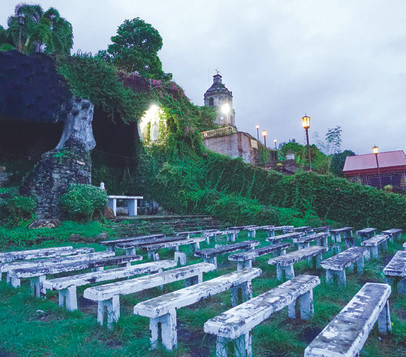ILOCOS SUR: A TAPESTRY OF NATURAL AND MANMADE WONDERS
BY NEPHELINE LIM DACUNO
A Tapestry of Natural
ILOCOS SUR IS PROOF THAT THE PHILIPPINES HAS A LOT MORE TO OFFER THAN JUST POSTCARD-PERFECT BEACHES. RICH IN HISTORY, CULTURE, AND JAW-DROPPING LANDSCAPES, THIS NORTHERN GEM IS READY TO STEAL THE SPOTLIGHT
The Philippines, with its more than 7000 islands, is a place that often comes to life on social media—clear blue waters, soft white sand, and nature at its finest. It is the image that many of us picture when we think of the country. But the Philippines has so much more to offer, and one place that truly captures its essence is Ilocos Sur. This northern province might not always make the headlines, but it has a rich history, vibrant culture, and natural beauty that is hard to beat. More and more travelers are discovering that there is a lot more to the Philippines than the typical postcard sights—and Ilocos Sur is definitely one of the places to put on your list if you are looking for something truly special.
VIGAN AND HERITAGE VILLAGE
Start your adventure on Heritage Village, the city’s iconic street, where the old-world charm is so thick you can almost taste it. As you wander, you will find yourself surrounded by quaint shops, inviting dining spots, and the ever-present kalesas— horse-drawn carriages that will give you a nostalgic tour of the city. Along the way, the delicious scent of Ilocano empanada and longganisa wafts through the air, tempting you to duck into one of the hidden eateries tucked behind colonial facades. It is a perfect blend of history and flavor that will leave you wanting more.
ILOCOS SUR MUSICAL DANCING FOUNTAIN

Tucked between the provincial capitol and St. Paul’s Cathedral, the Ilocos Sur Musical Dancing Fountain offers a fun way to end your day. As the evening sets in, the fountain comes alive with water dancing to upbeat tunes, while colorful lights illuminate the streams. The show runs for about 30 minutes, filling the entire length of the lagoon at Plaza Salcedo with energy. It is a popular spot where both locals and visitors gather to watch, and it is easy to see why. After a day of exploring the historic streets of Vigan, this lively, light-hearted display offers the perfect way to unwind and take in the beauty of the city.
LOGO BEACH FLOATING COTTAGES

If you are looking to escape the crowds and find a beach that still has that hidden treasure vibe, Logo Beach Floating Cottages in the town of Sinait is where you need to be. A stone’s throw away from Vigan, this place feels like the best-kept secret in the province—quiet, clean, and blissfully tourist-free.
The beach is exactly what you would picture: soft white sand, crystal-clear water, and little to no distractions (apart from a few curious locals, of course).
But the real star of the show? The floating cottages. These quirky little gems sit right on the water, with a hole in the middle that lets you dive straight into the sea—no need for complicated diving gear or a pricey boat tour. You can literally lounge, dip, and repeat all day long. And do not stress if you are visiting during peak season and all the floating cottages are booked; there are beach cottages available too. For around Php700 to Php1500, you get a full day of relaxation with your family or friends.
Even if you do not have the luxury of a full day lounging in the floating cottages, make sure you carve out some time to visit the coast of Lugo Beach. According to legend, this very beach is where the locals recovered a box in the 1600s that contained the image of the Santo Cristo Milagroso, or Apo Lakay, as the residents affectionately call it. Today, the image is now enshrined at Minor Basilica of Tolentino Sanctuary of Sto. Cristo and the replica of the statue is placed in the small chapel along the shore of the beach.
PINAKBET FARM

Hungry for a taste of local culture? Head over to Pinakbet Farm in the nearby town of Caoayan, where your appetite will meet tradition in the most delicious way. Owned by the municipal government, this is not your average farm-to-table spot—it is a authentic kamayan-style dining experience where forks, spoons, and knives take a backseat to good old fashioned finger licking fun.
Here, meals are served in a bilao (winnowing basket), and servers plate your feast into individual baskets. Their star dish? Pinakbet, of course! The restaurant’s version is a medley of freshly cooked vegetables served straight out of a bamboo stem. Wash down your meal with tanglad (lemongrass) juice and end the feast with balikutcha (pulled sugar candy). With every bite, you will savor the flavor of locally grown produce harvested right from their farm. Come hungry, leave happy— and maybe a little more connected to the land.
CORAZON C. AGOSTO ETHNIC HANDWOVEN CENTER

No trip to Ilocos Sur is complete without exploring the art of traditional pinilian weaving. The eponymous Corazon C. Agosto Ethnic Handwoven Center in the town of Santiago, established by the master weaver after whom it was named, proudly preserves this intricate craft. This 50-year-old weaving hub employs 20 skilled artisans from the Agosto family, who endeavor to keep their techniques authentic and their heritage alive. Each day, they create about 20 table runners, priced at Php1800, and stunning handwoven bags starting at Php1500. If you are searching for a meaningful keepsake, these handmade textiles offer a beautiful way to take a piece of Ilocano culture home with you.

SANTIAGO COVE
Santiago Cove is often lovingly referred to as La Union’s quieter sister. With its finer sand, gentler seas, and noticeably smaller crowds, it is the perfect retreat for those seeking tranquility. While it may lack the floating cottages of Lugo Beach, Santiago Cove more than makes up for it with its serene ambiance and unspoiled beauty. As the day winds down, the beach transforms into a front-row seat to one of the most majestic sunsets in the region. Picture this: the sun dipping below the horizon, its golden hues framed by swaying palm trees and a pristine stretch of white sand. If you prefer sunbathing to surfing and crave a peaceful escape, this hidden gem in the north deserves a spot on your itinerary.
AW-ASEN FALLS

If you are chasing a natural wonder that truly lives up to the name, consider Aw-Asen Falls as a must-visit spot. Known as the “Enchanted Aw-Asen Falls,” the waterfall is located at Barangay Santo Rosario, Sigay, Ilocos Sur. Its beauty is the kind that words—or even photos—cannot quite capture. The adventure begins with a trek through lush forests, where every step brings you closer to this hidden gem. When you finally arrive, the sight of the falls plunging into its clear basin is nothing short of magical. And the best part? You can cool off with a refreshing dip, letting the cascading waters add a little enchantment to your experience.
SKYLINE ILOCOS SUR

After conquering the trek to Aw-Asen Falls, reward yourself with a scenic drive to the Skyline View Deck in Quirino. Perched high in the Ilocos mountains, this breathtaking spot is famous for its mesmerizing “sea of clouds” phenomenon. Imagine standing above the world as thick clouds blanket the mountain peaks, creating an illusion of floating on a celestial ocean.
For the most magical experience, visit at sunrise when the clouds are at their thickest and the golden hues of dawn light up the horizon. But do not worry if early mornings aren’t your thing—the view deck offers stunning vistas all day long. From its perch, you can marvel at the rolling terraces, rugged mountains, and lush greenery that make this spot a must-visit for nature lovers and photography enthusiasts alike.
SANTUARIO DE NUESTRA SEÑORA DE LA ASUNCION CHURCH
Ilocos Sur is home to an array of centuries-old churches, but the Santuario de Nuestra Señora de la Asuncion Church, or Santa Maria Church, is in a league of its own. Often featured in bridal fairs and known as one of the province’s top wedding venues, this architectural masterpiece also holds the distinction of being a UNESCO World Heritage Site, one of the four Baroque churches of the Philippines on the list.
Its striking facade is a showstopper, but here is the twist: you will need to put in some legwork to admire it up close. Perched on a hill, the church is accessible via a grand stairway with 85 steps. It is a workout, no doubt, but the reward is well worth the effort. At the top, you will be greeted by sweeping views, a sense of history, and a welldeserved moment of triumph. Think of it as combining sightseeing with a fitness challenge!
MORO WATCHTOWER
The Moro Watchtower, built in the 16th century, proudly holds the title of the oldest landmark in the town of San Esteban. This historic structure was constructed as a defensive outpost during the height of the Spanish-Moro Wars, a centuries-long conflict that began in the 1500s. Standing as a silent witness to centuries of history, the watchtower remains a testament to the resilience and strategic ingenuity of its time. Visitors can explore the tower up close, stepping inside to reach the top of the tower.
MINOR BASILICA OF ST. NICHOLAS OF TOLENTINO SANCTUARY OF STO. CRISTO

Founded in 1574, the Minor Basilica of St. Nicholas of Tolentino Sanctuary of Sto. Cristo, also known as the Sinait Basilica, is one of the oldest religious structures in the Philippines. Its striking facade commands attention, but what lies within is just as captivating.

Step inside, and you will find yourself awestruck by the towering ceilings and, more importantly, the revered shrine of Apo Lakay, also known as Santo Milagroso. Remember the statues that were found ashore at Lugo Beach centuries ago? They are now housed at the shrine, inviting pilgrims and curious travelers alike to marvel at their beauty and the history they embody.
MAPISI ROCK
Ilocos Sur is not just about churches and historic streets—the province also boasts some awe-inspiring natural wonders. One of the most remarkable sights is Mapisi Rock, a striking formation of coral rocks located in Santiago. These massive boulders, which have split apart to create a cave-like structure, stand tall and you can see the natural marbling of the rocks embedded inside. Locals believe the rocks were split by a natural event, likely an earthquake, leaving behind this captivating formation. You can use your imagination as to how it was formed!




















